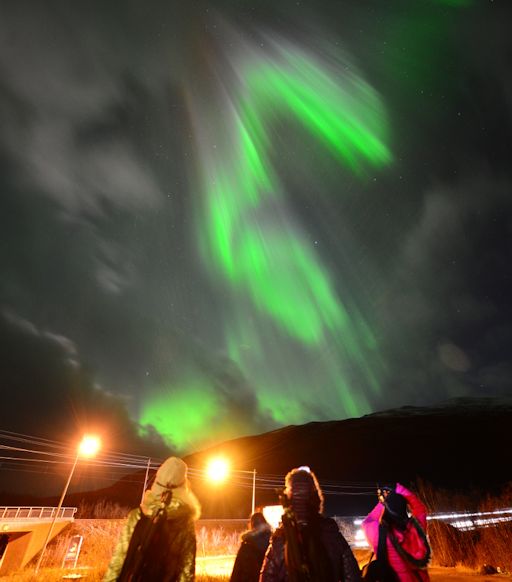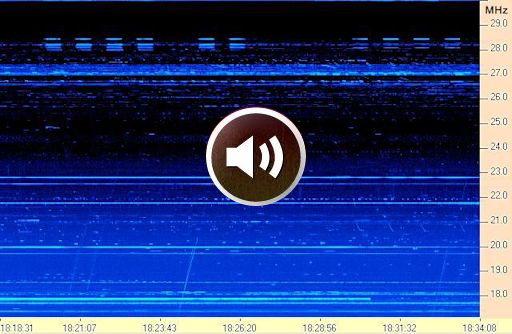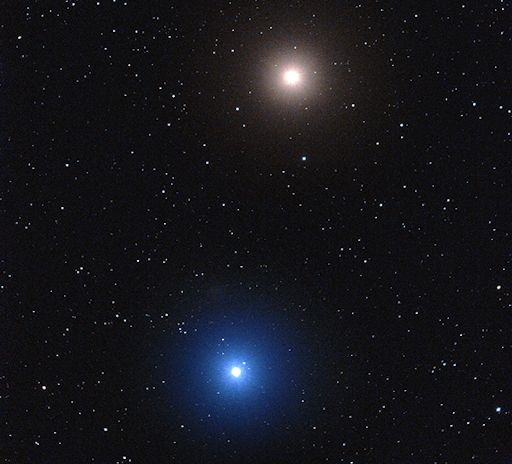Listen to radar echoes from satellites and meteors, live on listener-supported Space Weather Radio. | | |
SCROLL DOWN FOR FIREBALLS: There's something new on Spaceweather.com. Scroll down the page and look for the "All Sky Fireball Network." Every night (even during a government shutdown) NASA scans the skies for meteoritic fireballs. Every morning, we'll be presenting their results from the night before. The data include orbits, velocity, penetration depth in Earth's atmosphere and more.
WEAK IMPACT, AURORAS ANYWAY: As expected, a CME hit Earth's magnetic field this morning, Oct. 15th @ 10:00 UT. Earth was already surrounded by a gusty stream of solar wind when the CME arrived, so the signature of the CME's impact was almost indiscernable. Nevertheless, Arctic sky watchers got an eyeful. The solar wind stream itself fueled a fine display of auroras:

"It was another great night in the Abisko National Park," says aurora tour guide Chad Blakley of Abisko, Sweden. "Our guests from Singapore and India were walking back to the hotel when an amazing corona developed overhead. I can not wait to see what the next few nights have to offer."
Indeed, more auroras may be in the offing. NOAA forecasters estimate a 20% chance of polar geomagnetic storms as the solar wind continues to blow. Aurora alerts: text, voice.
Realtime Aurora Photo Gallery
MORSE CODE BEAMED INTO SPACE: When NASA's Juno spacecraft flew past Earth on Oct. 9th, ham radio operators around the world took part in a global effort to communicate with the spacecraft. Organized by the Juno mission team and JPL, the hams slowly tapped out "Hi" in Morse code: 
 . In New Mexico, amateur radio astronomer Thomas Ashcraft was observing the heavens with his own shortwave radio telescope when he heard the transmissions:
. In New Mexico, amateur radio astronomer Thomas Ashcraft was observing the heavens with his own shortwave radio telescope when he heard the transmissions:

"The patterned keying from amateur radio operators was noted clearly on my radio telescope," says Ashcraft. "In the dynamic spectrum, shown above, it is the series of horizontal 'dots' just above 28 MHz." Listening to this seven minute extract of the signal pattern sent to Juno takes patience, so Ashcraft sped up the recording by 10 times. "Here it is," he says.
Juno listened for the message using its onboard WAVES instrument, a radio and plasma wave sensor designed to study magnetic storms at Jupiter. Did Juno actually hear anything? The Juno mission team wrote this on the event's home page: "Thank you amateur radio operators. This activity is now concluded. The Juno team hopes to share the results with you soon."
Realtime Space Weather Photo Gallery
HOW TO FIND COMET ISON: How do you find Comet ISON? Wake up before dawn, face east, and follow the "double star." Rising about three hours before the sun, red Mars and blue-white Regulus have converged to form a bright pair separated by only 1o. Martin Gembec photographed the duo from the Czech Republic before daybreak on Oct. 14th.

To find Comet ISON, take a look at the full-sized image. The comet is just above Mars.
On Nov. 28th, Comet ISON could become spectacularly bright when it flies through the atmosphere of the sun. At the moment, though, it is still far away (near Mars) and faint. Visibility requires a telescope. Amateur astronomers, if you have a GOTO telescope, enter these coordinates, or just find the "double star" and draw a line between Regulus and Mars. It leads to ISON. Sky map: Oct. 15.
Realtime Comet ISON Photo Gallery
Realtime Aurora Photo Gallery
NEW: Every night, a network of
NASA all-sky cameras scans the skies above the United States for fireballs--that is, meteors brighter than Venus. Automated software maintained by NASA's Meteoroid Environment Office calculates their orbits, velocity, penetration depth in Earth's atmosphere and many other characteristics. Daily results are presented here on Spaceweather.com.
On Oct. 15, 2013, the network detected 3 fireballs.
(2 sporadics, 1 chi Taurid)

In this diagram of the inner solar system, all of the fireball orbits intersect at a single point--Earth. The orbits are color-coded by velocity, from slow (red) to fast (blue). [Larger image] [movies]
Potentially Hazardous Asteroids (
PHAs) are space rocks larger than approximately 100m that can come closer to Earth than 0.05 AU. None of the known PHAs is on a collision course with our planet, although astronomers are finding
new ones all the time.
On October 15, 2013 there were 1432 potentially hazardous asteroids.
Notes: LD means "Lunar Distance." 1 LD = 384,401 km, the distance between Earth and the Moon. 1 LD also equals 0.00256 AU. MAG is the visual magnitude of the asteroid on the date of closest approach. | | The official U.S. government space weather bureau |
| | The first place to look for information about sundogs, pillars, rainbows and related phenomena. |
| | Researchers call it a "Hubble for the sun." SDO is the most advanced solar observatory ever. |
| | 3D views of the sun from NASA's Solar and Terrestrial Relations Observatory |
| | Realtime and archival images of the Sun from SOHO. |
| | from the NOAA Space Environment Center |
| | the underlying science of space weather |

